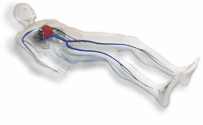DVT Complications: Pulmonary Embolism and Post-Thrombotic Syndrome (PTS)
Pulmonary Embolism
Pulmonary embolism is a major complication of deep–vein thrombosis (DVT).
A DVT blood clot has the potential to move into the lungs and block circulation
to the lungs – a life-threatening condition called pulmonary embolism
(PE) – which requires immediate medical attention.
PE occurs when a blood clot breaks loose from the wall of a vein and travels to
the lungs, blocking the pulmonary artery or one of its branches. This blocks the
blood flow from the heart. Obstruction of a large pulmonary artery by one or more
of these migrating clots (emboli) may be life threatening.
Symptoms of a pulmonary embolism may include:2
- Unexplained shortness of breath
- Chest pain or breathing
- Rapid heart rate
- Unexplained coughing
- Coughing up blood
Approximately 300,000 Americans die each year from PE,5
the majority of which result from DVT.9
Complications from DVT kill more Americans than breast cancer and AIDS combined.10
Anyone experiencing these symptoms should call for assistance and go to a hospital
immediately.

|
Click here to view
a video that explains pulmonary embolism as a serious complication of DVT.
|
Post-Thrombotic Syndrome (PTS)
Post-thrombotic syndrome (PTS) can occur after experiencing a DVT. The affected
limb can become chronically swollen and painful.11
The PTS is a long-term complication of DVT that is identified by:10
- Chronic, persistent pain
- Chronic swelling
- Development of varicose veins
PTS is common in people who have experienced a DVT and is difficult to diagnose
because symptoms are similar to DVT. An estimated 330,000 people in the US have
this condition.10
Little is known about who will or will not develop PTS. Generally, of the 60 percent
who has experienced a DVT in the legs, 40 percent will experience PTS. This condition
usually occurs in the first 6 months following a DVT but can also appear up to 2
years.10

|
Click here to read and share the Coalition's informational brochure
on the signs, symptoms and risk factors associated with DVT/PE.
|